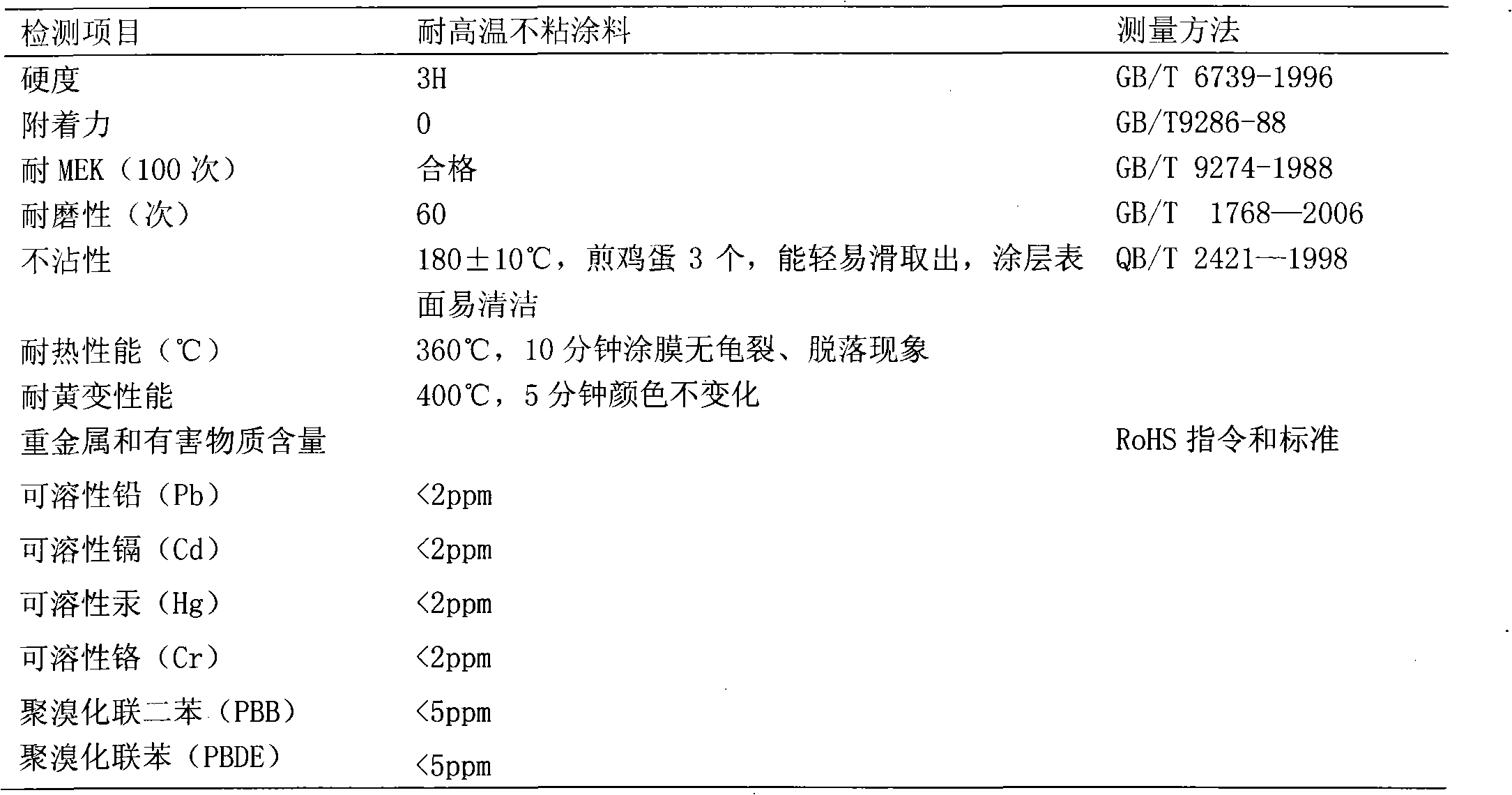High-temperature resistant non-sticking coating
A non-stick coating, high temperature resistant technology, applied in polyester coatings, coatings, etc., can solve the problems affecting the application of non-stick coatings, low resin affinity, poor dispersion performance, etc., to achieve good non-stick performance, solvent resistance, etc. The effect of high performance and excellent weather resistance
- Summary
- Abstract
- Description
- Claims
- Application Information
AI Technical Summary
Problems solved by technology
Method used
Image
Examples
Embodiment 1
[0030] 1) Synthesis of polyhydroxyl branched saturated polyester
[0031] a) Raw materials:
[0032] Neopentyl glycol 62.4g (0.6mol);
[0033] 2-methyl-1,3 propanediol 27g (0.3mol);
[0034] Trimethylolpropane 13.4g (0.1mol);
[0035] 132.8g (0.8mol) of isophthalic acid;
[0036] b) synthesis steps:
[0037] Add neopentyl glycol, 2-methyl-1,3 propanediol, and trimethylolpropane into a reactor equipped with heating, condensation, and nitrogen protection, and raise the temperature to 160°C under nitrogen protection to melt the polyol; then add Isophthalic acid and 0.4g tetrabutyl titanate were heated and kept at a temperature of 180°C for 4 hours, 220°C for 2 hours, and 240°C for 2 hours; finally cooled to 160°C, adding propylene glycol methyl Ether acetate was used to adjust the solid content to 60%, and cooled to room temperature to obtain 349 g of polyhydroxyl branched saturated polyester with a solid content of 60%.
[0038] c) Performance of polyhydroxyl branched satu...
Embodiment 2
[0070] 1) Synthesis of polyhydroxyl branched saturated polyester
[0071] a) Composition:
[0072] Neopentyl glycol 83.2g (0.8mol);
[0073] 13.5g (0.15mol) of 2-methyl-1,3 propanediol;
[0074] Trimethylolpropane 6.7g (0.05mol);
[0075] 149.4g (0.9mol) of isophthalic acid;
[0076] b) synthesis steps:
[0077] Add neopentyl glycol, 2-methyl-1,3 propanediol, and trimethylolpropane into a reactor equipped with heating, condensation, and nitrogen protection, and raise the temperature to 160°C under nitrogen protection to melt the polyol; then add Isophthalic acid and 0.4g tetrabutyl titanate; heated and kept at a temperature of 190°C for 4 hours, then heated to 230°C for 2.5 hours, and heated at 260°C for 2 hours; to reach the theoretical water output 91%, finally cooled to 160°C, adding propylene glycol methyl ether acetate to adjust the solid content to 60%, cooled to room temperature to obtain 347g of polyhydroxy branched saturated polyester with a solid content of 60%....
Embodiment 3
[0111] 1) Synthesis of polyhydroxyl branched saturated polyester
[0112] a) Composition:
[0113] Neopentyl glycol 57.2g (0.55mol);
[0114] 2-methyl-1,3 propanediol 31.5g (0.35mol);
[0115] Trimethylolpropane 13.4g (0.1mol);
[0116] Isophthalic acid 141.1g (0.85mol);
[0117] b) synthesis steps:
[0118] Add neopentyl glycol, 2-methyl-1,3 propanediol, and trimethylolpropane into a reactor equipped with heating, condensation, and nitrogen protection, and raise the temperature to 160°C under nitrogen protection to melt the polyol; then add Isophthalic acid and 0.4g of tetraisobutyl titanate are heated and heated at 200°C for 4 hours, 230°C for 2 hours, and 250°C for 2 hours; 95%, finally cooled to 160°C, adding propylene glycol methyl ether acetate to adjust the solid content to 60%, cooled to room temperature to obtain 352g of polyhydroxy branched saturated polyester with a solid content of 60%.
[0119] c) Performance:
[0120] The hydroxyl value of polyhydroxyl branc...
PUM
| Property | Measurement | Unit |
|---|---|---|
| Hydroxyl value | aaaaa | aaaaa |
| Hydroxyl value | aaaaa | aaaaa |
| Hydroxyl value | aaaaa | aaaaa |
Abstract
Description
Claims
Application Information
 Login to View More
Login to View More - R&D
- Intellectual Property
- Life Sciences
- Materials
- Tech Scout
- Unparalleled Data Quality
- Higher Quality Content
- 60% Fewer Hallucinations
Browse by: Latest US Patents, China's latest patents, Technical Efficacy Thesaurus, Application Domain, Technology Topic, Popular Technical Reports.
© 2025 PatSnap. All rights reserved.Legal|Privacy policy|Modern Slavery Act Transparency Statement|Sitemap|About US| Contact US: help@patsnap.com



